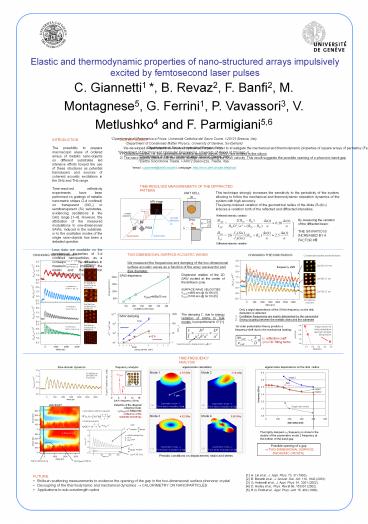Diapositiva 1 PowerPoint PPT Presentation
Title: Diapositiva 1
1
Elastic and thermodynamic properties of
nano-structured arrays impulsively excited by
femtosecond laser pulses
C. Giannetti1 , B. Revaz2, F. Banfi2, M.
Montagnese5, G. Ferrini1, P. Vavassori3, V.
Metlushko4 and F. Parmigiani5,6 1Dipartimento di
Matematica e Fisica, Università Cattolica del
Sacro Cuore, I-25121 Brescia, Italy 2Department
of Condensed Matter Physics, University of
Genève, Switzerland 3Dipartimento di Fisica,
Università di Ferrara, Italy 4Department of
Electrical and Computer Engineering, University
of Illinois at Chicago, IL 5Dipartimento di
Fisica, Università degli Studi di Trieste,
Italy 6Elettra Sincrotrone Trieste, I-34012
Basovizza, Trieste, Italy email
c.giannetti_at_dmf.unicatt.it, webpage
http//www.dmf.unicatt.it/elphos/
INTRODUCTION The possibility to prepare
macroscopic areas of ordered arrays of metallic
nano-objects on different substrates led
intensive efforts toward the use of these
structures as potential transducers and sources
of coherent acoustic excitations in the GHz and
THz range. Time-resolved reflectivity
experiments have been performed on gratings of
metallic nanometric stripes (2-d confined) on
transparent (SiO2) or semitransparent (Si)
substrates, evidencing oscillations in the GHz
range 14. However, the attribution of the
measured modulations to one-dimensional SAWs,
induced in the substrate, or to the oscillation
modes of the single nano-objects has been a
debated question. Less data are available on
the mechanical properties of 3-d confined
nanoparticles, as a consequence of the
difficulties in measuring and modeling the
elastic and thermodynamic properties of these
systems.
- OUR APPROACH
- We developed a dedicated time-resolved
optical technique, in order to investigate the
mechanical and thermodynamic properties of square
arrays of permalloy (Fe20Ni80) nano-disks
deposited on a Si(100) surface. Exploiting the
periodicity of the system, we have measured the
relaxation dynamics of the intensity of the
first-order diffracted beam, after the excitation
by sub-ps laser pulses. By changing the
parameters of the samples, we demonstrate that - Collective modes, i.e. two-dimensional surface
acoustic waves (SAW), are excited in the silicon - The nano-objects interact with the silicon
surface renormalizing the SAW velocity. This
result suggests the possible opening of a
phononic band-gap
TIME-RESOLVED MEASUREMENTS OF THE DIFFRACTED
PATTERN
This technique strongly increases the sensitivity
to the periodicity of the system, allowing to
follow the mechanical and thermodynamic
relaxation dynamics of the system with high
accuracy. The pump-induced variation of the
geometrical radius of the disks (da(t)/a) induces
a variation both of the reflected and diffracted
intensities.
Reflected intensity variation
By measuring the variation of the diffracted
beam THE S/N RATIO IS INCREASED BY A FACTOR 9
Diffracted intensity variation
TWO-DIMENSIONAL SURFACE ACOUSTIC WAVES We
measured the frequencies and damping of the
two-dimensional surface acoustic waves as a
function of the array wavevector and disk
diameter.
CHANGING THE DISK RADIUS
Constant periodicities and thicknesses
frequency shift
Dispersion relation of the 2D SAW excited at the
center of the Brillouin zone. SURFACE WAVE
VELOCITIES VSAW4900 m/s _at_ Si(100) 5 VSAW5100
m/s _at_ Si(110) 5
SAW dispersion
- Only a slight dependence of the SAWs frequency
on the disk diameters is detected - Oscillation frequencies are mainly determined by
the wavevector - Strong coupling between the metallic disks and
the substrate
The damping ?, due to energy radiation of SAWs to
bulk modes, is proportional to G4 1.
SAW damping
1st order perturbation theory predicts a
frequency-shift due to the mechanical loading
Failure of the 1st order perturbative approach at
large filling factors
rS reflection coeff. ??a2/D2 filling factor
Initial transverse displacement uz0? h-1
TIME-FREQUENCY ANALYSIS
eigenmodes calculation
eigenmodes dependence on the disk radius
time-domain dynamics
frequency analysis
Mode 1
Mode 2
4.19 GHz
3.78 GHz
G2
D10056 nm 2a7857 nm h512 nm
?SAW
Si(100)
G1
Si(110)
?2
1 µm
Symmetric mode ? Form-factor modulation at ?
Asymmetric mode ? Form-factor modulation at 2?
WAVELET
- Detection of the diagonal collective mode
- ?2/?SAW1.3860.004
- influence of the
- substrate anisotropy
Single disk modes
data
excitation
Convolution with the wavelet
Mode 3
Mode 4
4.52 GHz
5.80 GHz
C-Morlet wavelet
SAW
The highly damped ?3 frequency is close to the
double of the asymmetric mode 2 frequency at the
bottom of the band-gap
3-frequency fit
? heat-exchange time ? 1/?-? ? (?02-?2)1/2
?2
Possible opening of a gap ? TWO-DIMENSIONAL
SURFACE PHONONIC CRYSTAL
Asymmetric mode ? Form-factor modulation at 2?
Asymmetric mode ? Form-factor modulation at 2?
modes
?38.56 GHz
Periodic conditions on displacement, strain and
stress
?2-?SAW beating
highly damped ?3
1 H. Lin et al., J. Appl. Phys. 73, 37
(1993). 2 B. Bonello et al., J. Acoust. Soc.
Am. 110, 1943 (2001). 3 G. Antonelli et al.,
J. Appl. Phys. 91, 3261 (2002). 4 D. Hurley et
al., Phys. Rev.B 66, 153301 (2002). 5 R.G.
Pratt et al., Appl. Phys. Lett. 15, 403 (1969).
- FUTURE
- Brillouin scattering measurements to evidence the
opening of the gap in the two-dimensional surface
phononic crystal - Decoupling of the thermodynamic and mechanical
dynamics ? CALORIMETRY ON NANOPARTICLES - Applications to sub-wavelength optics

